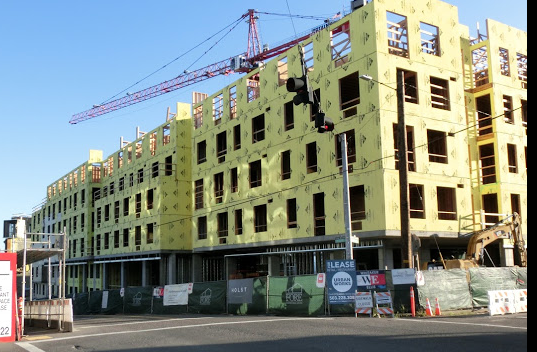The more you limit housing, the more you increase displacement
In city after city, we see the same refrain: a neighborhood is starting to attract new residents and new investment, current residents are starting to worry about gentrification. They show up at city council meetings or planning meetings to voice objection to new development. Just make it stop, so our neighborhood will stay the same, and residents won’t be displaced.

They’re often urged to emulate the tactics of NIMBY’s elsewhere, and stem the tide of change by blocking new development.
Slowing or stopping new development, particularly new housing development has exactly the opposite of the desired effect. It constricts the housing supply, drives up rents and fuels displacement.
We’ve seen this time and again. A couple of months back, we profiled two Oakland neighborhoods, Uptown and Fruitvale. Both experienced almost identical increases in rents and home values as the Bay Area city boomed. But Fruitvale, which has built more housing has seen dramatically less demographic change, while Uptown which has built almost no new housing, has seen its population shift.
The same holds for two neighborhoods in Washington DC’s 20003 zip code, Capitol Hill and the Navy Yard. Historic Capitol Hill has organized to largely block most new development; the Navy Yard area (near the new Washington Nationals ballpark) has seen thousands of new apartments built in the past decade. As Greater Greater Washington describes, the addition of new apartments has helped push down rents in the Navy Yard (the orange line) while rents in Capitol Hill (purple) continue to climb.
If you don’t build new housing, you intensify the shortage, raise the rents, and amplify the displacement. This isn’t intuitively obvious. People, unsurprisingly, associate new buildings with new residents, and simplistically assume that if new housing isn’t built, that new people won’t show up, or that they’ll simply go somewhere else. But that’s not the case. Recently, (again, as related by Greater Greater Washington) one Washington DC Councilor, Kenyan McDuffie, patiently explained how this works to one of his constituents, who was testifying against a new housing development, worrying that it would lead to greater displacement. McDuffie said:
So you can’t have a conversation about displacement and say “Don’t build these high end condos.” Perhaps we say no to all this stuff [the proposal before them includes 375 new homes, most market rate and 113 subsidized affordable homes]. It doesn’t mean those folks aren’t going to continue to come and need a place to live, and the price of housing is going to skyrocket because we don’t meet the demand that exists.
There’s no question that a big reason that some low income neighborhoods are seeing development pressure is because wealthier urban neighborhoods and suburbs generally have been so effective in deploying NIMBYist regulations that block development. As Brookings Institution’s Jenny Schuetz has shown, higher income neighborhoods in Washington have blocked most new housing development. It seems to have become an article of faith among some community activists that they can only succeed in empowering low income or distressed communities if they equip them to be just as NIMBYist as any snooty suburb or high end enclave. (Indeed, in some jurisdictions, local governments and activists bluntly employ zoning approval processes or regulations like California’s CEQA to extract concessions from developers.)
Sometimes planning discussions get the relationship between more construction and less displacement exactly backwards. Consider Seattle, which for the past several years has been working on a “Grand Bargain” to help promote greater affordability and equity by upzoning land throughout the city. So far, so good. But, it’s worried about the prospects for displacement in lower income neighborhoods. Erica C. Barnett wrote about this recently at the blog “The C is for Crank” in an article entitled “Anti-Density Activists Race and Social Justice Gotcha Backfires.”
Seattle’s answer for displacement concerns: lower the amount of upzoning in these neighborhoods. The city’s strategy, according to Barnett, was to reduce the amount of new housing that could be built in areas where community members raised concerns about displacement, based on the apparent assumption that lower amounts of upzoning will reduce displacement.
But that pretty much contradicts what we know about how displacement happens. Back to Erica C. Barnett:
Whether restricting the creation of housing—any type of housing—will work as a long-time anti-displacement strategy is, of course, another question—one that city council member Teresa Mosqueda posed at last week’s meeting. “I still struggle with the terminology that if we were to do more development—again, through the community lens, led by community organizations and neighborhood leaders who who can talk about the type of housing that they’d like to see—we can actually benefit by seeing increased housing and density requirements in some of these areas that are being called at risk of displacement.
“If they are at risk of displacement, then [it seems like] we would like to see more opportunities for folks to live in those areas and not get pushed out,” Mosqueda concluded.
In the game of musical chairs that is the urban housing market, the only way to make sure that all people find a place to sit–i.e. not be displaced–is to add more chairs. The research that’s been done on the subject, notably by California’s Legislative Analyst Office–and confirmed by the skeptical academics at U.S. Berkeley’s Anti-Displacement project–is that building more market rate housing reduces displacement.
On a visceral, political level, it does seem to be fair to suggest that if rich neighborhoods are able to block new housing, then poor neighborhoods ought to have the same prerogative. But that’s a road that leads nowhere: Empowering everyone to be NIMBYs in the hope that blocking new development will cause the demand for housing to go away or be absorbed somewhere else is a recipe for worsening housing affordability and greater displacement.
This post has been revised to correctly spell Erica C. Barnett’s name.


